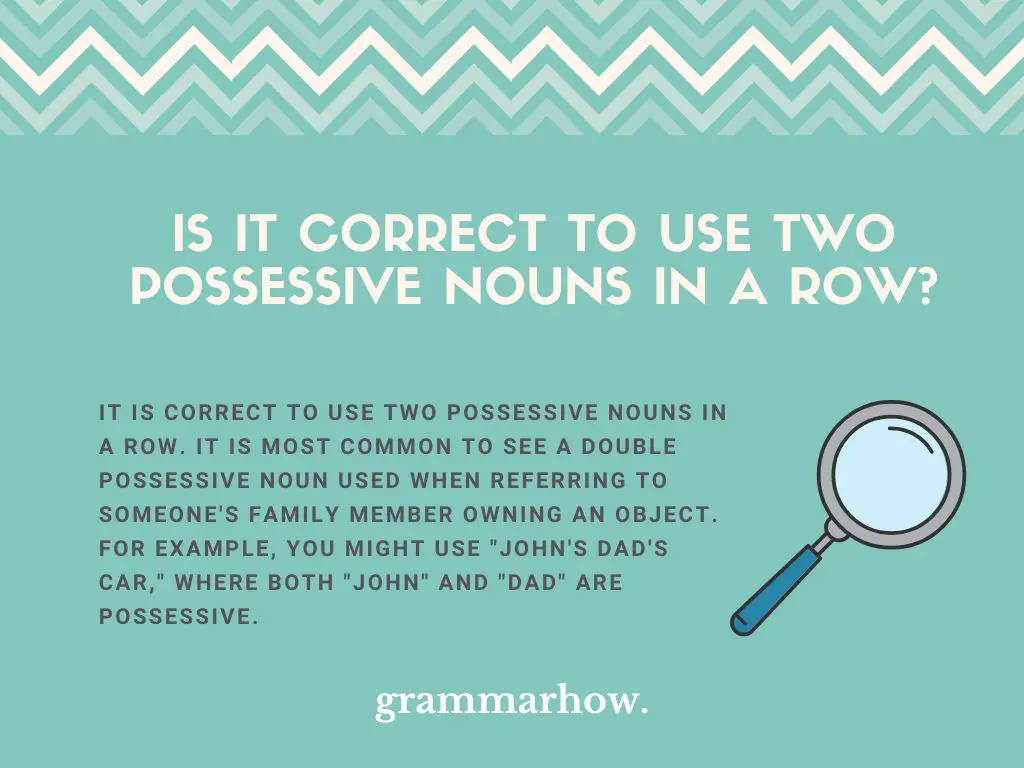Possessive nouns are used to show that someone (or something) owns an object in a sentence. You can also use them to own other possessive nouns, meaning that multiple nouns can follow each other. This article will explore when something like that can happen.
Is It Correct to Use Two Possessive Nouns in a Row?
It is correct to use two possessive nouns in a row. It is most common to see a double possessive noun used when referring to someone’s family member owning an object. For example, you might use “John’s dad’s car,” where both “John” and “dad” are possessive.

While two possessive nouns can be used in this way, they are still very specific in their usage. You will only find that people use double possessive forms like this when referring to a familial connection that someone might have.
For instance, if you know “Sarah” but you don’t know her “mom” very well, you would say “Sarah’s mom.” Then, if “Sarah’s mom” happens to own an object, you would also want to turn “mom” into a possessive to demonstrate this.
- Sarah’s mom’s house was broken into.
How Do You Punctuate Two Possessive Nouns in a Row?
You should always include apostrophes when you punctuate two possessive nouns in a row. Just like singular possessive nouns, apostrophes are required after the subject (followed by an “s”). This demonstrates the possessive form and shows who owns what object.
Other than apostrophes, no other punctuation is required. You don’t need to worry about commas or anything going between the two possessive nouns. Instead, they can touch each other without any issue.
If you’re wondering how to use two possessive nouns in a sentence, here’s how it looks:
- I was speaking to Sam’s dad’s friend about this, and I didn’t realize that there were so many other things going on here.
- Michael’s sister’s wardrobe is an absolute mess. I wonder if she’ll ever be able to tidy it up a little bit.
- Jonathan’s family’s home was destroyed by the flood. I wish there was something that we could do to help out.
- I found Danielle’s brother’s phone the other day. I knew he’d left it somewhere like an idiot!
- I thought about Craig’s father’s idea again. It was actually a lot smarter than I first gave it credit for. Maybe I should look into it.
- Peter’s dog’s bone was out in the yard again. His dog never goes out there, so Peter didn’t understand how it kept moving.
- Joseph’s mother’s will had a lot of questionable things in it. I’m sure he didn’t want us to hear about that.
As you can see, double possessive nouns are most common when demonstrating familial relationships. They show that someone you know owns a family member, and the family member is the person that owns the object in question.
More Than Two Possessive Nouns in a Row
You don’t have to stop at two possessive nouns, either. It’s correct to include as many as you need, as long as the structure of the relationship between the possessive objects is made clear. However, most people stick to two at a maximum.
Anything more than two is considered redundant and unnecessary. Most people avoid multiple possessives because of how they sound in their writing.
For example:
- Sam’s maid’s father’s gin is the best thing I’ve ever tasted.
Here, three possessive nouns are used, but it’s a bit of a mouthful. Most people will avoid using a sentence like this because it doesn’t flow smoothly.
If you wanted to tidy up the sentence a bit, it would help to remove one of the possessive nouns. The removed noun depends entirely on the context, but in this case, you can do it like so:
- The maid’s father’s gin is the best thing I’ve ever tasted.
- His maid’s father’s gin is the best thing I’ve ever tasted.
Technically, “his” is still a possessive noun, but it’s a bit easier to work into the sentence since it doesn’t rely on an apostrophe.
Final Thoughts
You can use two (or more) possessive nouns in a row, but you need to make sure the sentence warrants it. It is common to use this when showing a familial connection, especially when you don’t know the person that owns the object, but you know their relative.

Martin holds a Master’s degree in Finance and International Business. He has six years of experience in professional communication with clients, executives, and colleagues. Furthermore, he has teaching experience from Aarhus University. Martin has been featured as an expert in communication and teaching on Forbes and Shopify. Read more about Martin here.
